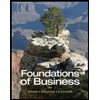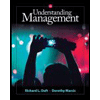
Principles of Management
OER 2019 Edition
ISBN: 9780998625768
Author: OpenStax
Publisher: OpenStax College
expand_more
expand_more
format_list_bulleted
Textbook Question
Chapter 3.5, Problem 2CC
How did their work compare to Taylor’s?
Expert Solution & Answer
Want to see the full answer?
Check out a sample textbook solution
Students have asked these similar questions
Two ways a workbook can be used in Business Management
6 strategies to encourage a risk aware culture in the workplace
3. Critically examine the importance of organisational culture in embedding risk management
principles in a business. Suggest strategies to strengthen a risk-aware culture.
(20 marks)
Chapter 3 Solutions
Principles of Management
Ch. 3.1 - What were the contributions of the following...Ch. 3.2 - What was the Italian Renaissance?Ch. 3.2 - What managerial legacy did it leave?Ch. 3.3 - Why was Adam Smiths specialization of labor so...Ch. 3.3 - What was the economic and managerial legacy of the...Ch. 3.4 - List the contributions from Taylor and his...Ch. 3.4 - How did Taylor change management?Ch. 3.5 - What were the contributions of Fayol and Weber?Ch. 3.5 - How did their work compare to Taylors?Ch. 3.5 - What is the idea of line of authority and...
Ch. 3.6 - What did the Hawthorne studies, Barnard, and Fayol...Ch. 3.6 - What did the works of Follett and Mayo contribute...Ch. 3.7 - What is the going contribution of systems and...Ch. 3.7 - What is the idea of evidence-based management?Ch. 3 - What contributions did ancient civilizations make...Ch. 3 - Describe the role of the Renaissance in shaping...Ch. 3 - How did the Industrial Revolution change business...Ch. 3 - Describe scientific management. How was scientific...Ch. 3 - Who were the key contributors to scientific...Ch. 3 - Describe the Hawthorne studies. Was Elton Mayo a...Ch. 3 - What is the zone of indifference?Ch. 3 - Describe Folletts concept of conflict resolution.Ch. 3 - What does open systems say about management?Ch. 3 - What is contingency management?
Additional Business Textbook Solutions
Find more solutions based on key concepts
•• B.4. Consider the following linear programming problem:
Operations Management
What is an action plan? Why are action plans such an important part of market planning? Why is it so important ...
MARKETING:REAL PEOPLE,REAL CHOICES
Sykes Corporations comparative balance sheets at December 31, Year 2 and Year 1, reported accumulated depreciat...
Intermediate Accounting (2nd Edition)
Why is the capital-budgeting process so important?
Foundations Of Finance
The exchange rate, potential risk, transfer pricing, tax law differences and strategies are the items affects t...
Gitman: Principl Manageri Finance_15 (15th Edition) (What's New in Finance)
11-9. Identify a company with a product that interests you. Consider ways the company could use customer relati...
Business Essentials (12th Edition) (What's New in Intro to Business)
Knowledge Booster
Similar questions
- 1. Discuss how the application of PESTEL analysis can assist small businesses in identifying and managing external risks. Provide examples from at least three PESTEL categories. (20 marks)arrow_forward. Mention four early warning indicators that a business may be at risk.arrow_forward5. A risk that has both a high impact and high probability is referred to as A. Negligible B. Moderate C. Low D. Extreme 6. A business continuity plan is mainly used to_ A. Increase profits B. Handle daily tasks C. Prepare for disruptions D. Advertise services 7. What is the role of a risk owner? A. To finance the risk B. To monitor and manage a specific risk C. To create risks D. To avoid planning 8. Early warning indicators help businesses to A. Avoid legal actions B. Grow rapidly C. Detect potential risks D. Hire employees 9. A hazard-based risk includes A. Political instability B. Ergonomic issues C. Market demand D. Taxation changesarrow_forward
- 1. What is the primary purpose of risk management in small businesses? A. To eliminate all risks B. To predict profits C. To reduce and control risks D. To create new risks 2. Which of the following is a type of operational risk? A. Interest rate change B. Natural disaster C. Supplier failure D. Tax policy change 3. SWOT analysis identifies all EXCEPT A. Strengths B. Weaknesses C. Tactics D. Opportunities 4. Which strategy involves taking no action against a risk? A. Mitigation B. Avoidance C. Acceptance D. Transferarrow_forward5. A risk that has both a high impact and high probability is referred to as A. Negligible B. Moderate C. Low D. Extreme 6. A business continuity plan is mainly used to_ A. Increase profits B. Handle daily tasks C. Prepare for disruptions D. Advertise services 7. What is the role of a risk owner? A. To finance the risk B. To monitor and manage a specific risk C. To create risks D. To avoid planning 8. Early warning indicators help businesses to A. Avoid legal actions B. Grow rapidly C. Detect potential risks D. Hire employees 9. A hazard-based risk includes A. Political instability B. Ergonomic issues C. Market demand D. Taxation changesarrow_forward1. What is the primary purpose of risk management in small businesses? A. To eliminate all risks B. To predict profits C. To reduce and control risks D. To create new risks 2. Which of the following is a type of operational risk? A. Interest rate change B. Natural disaster C. Supplier failure D. Tax policy change 3. SWOT analysis identifies all EXCEPT A. Strengths B. Weaknesses C. Tactics D. Opportunities 4. Which strategy involves taking no action against a risk? A. Mitigation B. Avoidance C. Acceptance D. Transferarrow_forward
- List and briefly describe four risk response strategies.arrow_forwardExplain the purpose of a risk register.arrow_forwardAssume that your business is going to apply for a bank loan. Step into the shoes of a banking official who has the power to say yes or no to your loan application. From the bank’s vantage point, what are the strengths and weaknesses of your business plan? Does your plan seem realistic, given the financial assumptions and the business environment? What questions would you, as a bank officer, ask about your business plan? As the entrepreneur behind the business plan, how would you answer these questions and persuade the bank to approve your loan? Write up your questions and answers in one paragraph. Then use what you’ve learned to further strengthen your plan.arrow_forward
- Assume that your business is going to apply for a bank loan. Step into the shoes of a banking official who has the power to say yes or no to your loan application. From the bank’s vantage point, what are the strengths and weaknesses of your business plan? Does your plan seem realistic, given the financial assumptions and the business environment? What questions would you, as a bank officer, ask about your business plan? As the entrepreneur behind the business plan, how would you answer these questions and persuade the bank to approve your loan? Write up your questions and answers in one paragraph. Then use what you’ve learned to further strengthen your plan.arrow_forwardEven before you launch your business, you have to be ready to handle the funds that will flow in and out as you buy raw materials, pay rent, receive customer payments, and reserve cash to pay taxes. Which financial services should you have in place on your first day in business? Which might be needed months later, after you’ve established your business? Write two to three sentences about your company’s need for financial services, now and during the first year.arrow_forwardChester has negotiated a new labor contract for the next round that will affect the cost for their product Camp. Labor costs will go from $3.65 to $4.15 per unit. Assume all period and variable costs as reported on Chester's Income Statement remain the same. If Chester were to pass on half the new labor costs to their customers, how many units of product Camp would need to be sold next round to break even on the product? Select : 1 a) 1,826 b) 1,916 c) 1,743 d) 2,428arrow_forward
arrow_back_ios
SEE MORE QUESTIONS
arrow_forward_ios
Recommended textbooks for you
 Foundations of Business (MindTap Course List)MarketingISBN:9781337386920Author:William M. Pride, Robert J. Hughes, Jack R. KapoorPublisher:Cengage Learning
Foundations of Business (MindTap Course List)MarketingISBN:9781337386920Author:William M. Pride, Robert J. Hughes, Jack R. KapoorPublisher:Cengage Learning Foundations of Business - Standalone book (MindTa...MarketingISBN:9781285193946Author:William M. Pride, Robert J. Hughes, Jack R. KapoorPublisher:Cengage Learning
Foundations of Business - Standalone book (MindTa...MarketingISBN:9781285193946Author:William M. Pride, Robert J. Hughes, Jack R. KapoorPublisher:Cengage Learning Understanding Management (MindTap Course List)ManagementISBN:9781305502215Author:Richard L. Daft, Dorothy MarcicPublisher:Cengage Learning
Understanding Management (MindTap Course List)ManagementISBN:9781305502215Author:Richard L. Daft, Dorothy MarcicPublisher:Cengage Learning


Foundations of Business (MindTap Course List)
Marketing
ISBN:9781337386920
Author:William M. Pride, Robert J. Hughes, Jack R. Kapoor
Publisher:Cengage Learning

Foundations of Business - Standalone book (MindTa...
Marketing
ISBN:9781285193946
Author:William M. Pride, Robert J. Hughes, Jack R. Kapoor
Publisher:Cengage Learning

Understanding Management (MindTap Course List)
Management
ISBN:9781305502215
Author:Richard L. Daft, Dorothy Marcic
Publisher:Cengage Learning